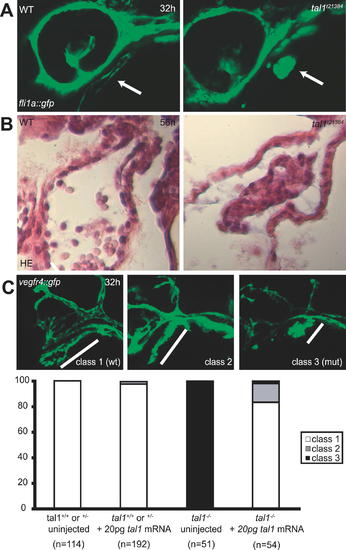
Defects in Endocardial Development in tal1t21384 Mutants (A) Confocal images of the head region from embryos transgenic for fli1a:gfp at 32 hpf. Arrows indicate the location of the endocardium. In the wt endocardium, a lumen is visible, which is absent in tal1t21384 mutants. (B) Transversal sections of wt and tal1t21384 mutant heart ventricles at 56 hpf stained with hematoxylin/eosin. In wt embryos, the endocardium forms an epithelium attached to the myocardium, and blood cells are visible within the heart tube. In the tal121384 mutant heart, the endocardium fails to form an epithelium and is only present in the heart ventricle. (C) Rescue of endocardial defects. Maximum z-projection of a stack of confocal images of embryos carrying the vegfr4:gfp transgene. Embryos were divided into three classes based on their endocardial phenotype. Class 1: wt length of the endocardium with normal tube formation (wt phenotype). Class 2: wt length of the endocardium but no tube formation (intermediate phenotype). Class 3: short endocardium with no tube formed (mutant phenotype). All embryos homozygous or heterozygous for the wt allele are in class 1, whereas all embryos homozygous for the tal1t21384 allele are in class 3, showing the high penetrance of this phenotype. In 43 out of 54 embryos homozygous for the tal1t21384 allele (83%), the endocardial phenotype can be rescued to class 1 through injection of low amounts of wt tal1 mRNA (20 pg per embryo), whereas most of the remaining (8/54, 15%) display an intermediate phenotype (class 2).
|

